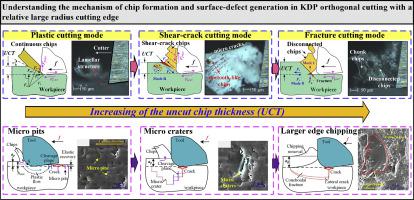当前位置:
X-MOL 学术
›
Mater. Des.
›
论文详情
Our official English website, www.x-mol.net, welcomes your feedback! (Note: you will need to create a separate account there.)
Mechanism of chip formation and surface-defects in orthogonal cutting of soft-brittle potassium dihydrogen phosphate crystals
Materials & Design ( IF 8.4 ) Pub Date : 2021-01-01 , DOI: 10.1016/j.matdes.2020.109327 Qi Liu , Zhirong Liao , Jian Cheng , Dongdong Xu , Mingjun Chen
Materials & Design ( IF 8.4 ) Pub Date : 2021-01-01 , DOI: 10.1016/j.matdes.2020.109327 Qi Liu , Zhirong Liao , Jian Cheng , Dongdong Xu , Mingjun Chen

|
Abstract Micromachining repair of surface defects on KH2PO4 (KDP) optics is an emerging technique in the construction of Inertial Confinement Fusion facilities for obtaining clean nuclear fusion energy. However, this method is yet facing considerable challenges owing to the soft-brittle nature of single-crystal KDP, hence it is necessary to understand its ductile-regime cutting mechanism to generate crack-free surfaces. This paper seeks to investigate the evolution of different cutting mechanism with the change of uncut chip thickness (UCT) in KDP orthogonal cutting processes. A transition of cutting modes from plastic cutting to shear-crack cutting and then fracture cutting with the rise of UCT has been revealed. To explain these cutting phenomena, a novel theoretical model was proposed by calculating the specific energy dissipation for crack/fracture propagations during cutting processes based on fracture mechanics. This analytical model was well validated by the analysis of cutting forces and machined surface quality. Nevertheless, three kinds of surface defects have been observed, i.e. micro pits, micro craters and edge chipping. These surface defects were caused by tearing and spalling of materials with elastic recovery, crack propagation along cleavage planes with ploughing effect, and the peeling away of large-size fracture, respectively. The presented results of great significance for promoting the application of micromachining processes in future engineering repair of KDP optics.
中文翻译:

软脆性磷酸二氢钾晶体正交切割切屑形成机制及表面缺陷
摘要 KH2PO4(KDP)光学器件表面缺陷的微加工修复是惯性约束聚变设施建设中获得清洁核聚变能的新兴技术。然而,由于单晶 KDP 的软脆性质,该方法仍面临相当大的挑战,因此有必要了解其延展性切割机制以生成无裂纹表面。本文旨在研究在 KDP 正交切削过程中,随着未切削切屑厚度 (UCT) 的变化,不同切削机制的演变。揭示了随着UCT的兴起,切削方式从塑性切削到剪切裂纹切削再到断裂切削的转变。为了解释这些切割现象,通过基于断裂力学计算切削过程中裂纹/断裂传播的比能量耗散,提出了一种新的理论模型。该分析模型通过对切削力和加工表面质量的分析得到了很好的验证。然而,已经观察到三种表面缺陷,即微凹坑、微坑和边缘碎裂。这些表面缺陷分别是由具有弹性恢复的材料撕裂和剥落、裂纹沿解理面的犁沟扩展以及大尺寸断裂剥离引起的。所呈现的结果对于推动微加工工艺在未来KDP光学工程维修中的应用具有重要意义。该分析模型通过对切削力和加工表面质量的分析得到了很好的验证。然而,已经观察到三种表面缺陷,即微凹坑、微坑和边缘碎裂。这些表面缺陷分别是由具有弹性恢复的材料撕裂和剥落、裂纹沿解理面的犁沟扩展以及大尺寸断裂剥离引起的。所呈现的结果对于促进微加工工艺在未来KDP光学工程维修中的应用具有重要意义。该分析模型通过对切削力和加工表面质量的分析得到了很好的验证。然而,已经观察到三种表面缺陷,即微凹坑、微坑和边缘碎裂。这些表面缺陷分别是由具有弹性恢复的材料撕裂和剥落、裂纹沿解理面的犁沟扩展以及大尺寸断裂剥离引起的。所呈现的结果对于促进微加工工艺在未来KDP光学工程维修中的应用具有重要意义。这些表面缺陷分别是由具有弹性恢复的材料撕裂和剥落、裂纹沿解理面的犁沟扩展以及大尺寸断裂剥离引起的。所呈现的结果对于促进微加工工艺在未来KDP光学工程维修中的应用具有重要意义。这些表面缺陷分别是由具有弹性恢复的材料撕裂和剥落、裂纹沿解理面的犁沟扩展以及大尺寸断裂剥离引起的。所呈现的结果对于促进微加工工艺在未来KDP光学工程维修中的应用具有重要意义。
更新日期:2021-01-01
中文翻译:

软脆性磷酸二氢钾晶体正交切割切屑形成机制及表面缺陷
摘要 KH2PO4(KDP)光学器件表面缺陷的微加工修复是惯性约束聚变设施建设中获得清洁核聚变能的新兴技术。然而,由于单晶 KDP 的软脆性质,该方法仍面临相当大的挑战,因此有必要了解其延展性切割机制以生成无裂纹表面。本文旨在研究在 KDP 正交切削过程中,随着未切削切屑厚度 (UCT) 的变化,不同切削机制的演变。揭示了随着UCT的兴起,切削方式从塑性切削到剪切裂纹切削再到断裂切削的转变。为了解释这些切割现象,通过基于断裂力学计算切削过程中裂纹/断裂传播的比能量耗散,提出了一种新的理论模型。该分析模型通过对切削力和加工表面质量的分析得到了很好的验证。然而,已经观察到三种表面缺陷,即微凹坑、微坑和边缘碎裂。这些表面缺陷分别是由具有弹性恢复的材料撕裂和剥落、裂纹沿解理面的犁沟扩展以及大尺寸断裂剥离引起的。所呈现的结果对于推动微加工工艺在未来KDP光学工程维修中的应用具有重要意义。该分析模型通过对切削力和加工表面质量的分析得到了很好的验证。然而,已经观察到三种表面缺陷,即微凹坑、微坑和边缘碎裂。这些表面缺陷分别是由具有弹性恢复的材料撕裂和剥落、裂纹沿解理面的犁沟扩展以及大尺寸断裂剥离引起的。所呈现的结果对于促进微加工工艺在未来KDP光学工程维修中的应用具有重要意义。该分析模型通过对切削力和加工表面质量的分析得到了很好的验证。然而,已经观察到三种表面缺陷,即微凹坑、微坑和边缘碎裂。这些表面缺陷分别是由具有弹性恢复的材料撕裂和剥落、裂纹沿解理面的犁沟扩展以及大尺寸断裂剥离引起的。所呈现的结果对于促进微加工工艺在未来KDP光学工程维修中的应用具有重要意义。这些表面缺陷分别是由具有弹性恢复的材料撕裂和剥落、裂纹沿解理面的犁沟扩展以及大尺寸断裂剥离引起的。所呈现的结果对于促进微加工工艺在未来KDP光学工程维修中的应用具有重要意义。这些表面缺陷分别是由具有弹性恢复的材料撕裂和剥落、裂纹沿解理面的犁沟扩展以及大尺寸断裂剥离引起的。所呈现的结果对于促进微加工工艺在未来KDP光学工程维修中的应用具有重要意义。



























 京公网安备 11010802027423号
京公网安备 11010802027423号